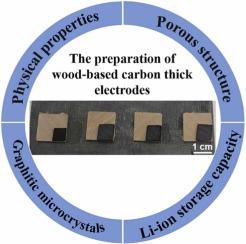The role of carbonization temperature and amorphous components for the design and optimization of wood-based hard carbon thick electrodes in lithium-ion batteries
IF 6.2
1区 农林科学
Q1 AGRICULTURAL ENGINEERING
引用次数: 0
Abstract
Recently, wood-based hard carbon thick electrodes (WHCTEs) have achieved widespread attentions due to their 3-D transport network and high areal capacity. However, the roles of components in woods, especially the lignin and hemicellulose in influencing physical properties, microstructure, and lithium storage performance of WHCTEs remains unclear, which limits the design and application of WHCTEs. Herein, the effects of the carbonization process and components on the structural derivation and lithium storage properties of WHCTEs were investigated by varying the carbonization temperature and removing the amorphous components. Birch wood was carbonized at 800, 1000, and 1200 °C (CW-800, CW-1000, and CW-1200), respectively. Samples removed amorphous components were also carbonized at 800 °C (DE-800). The XRD results proved that appropriately increasing the carbonization temperature and removing amorphous components improved the graphitization degree. The HRTEM results confirmed that higher carbonization temperature facilitated the formation of closed pores. As the carbonization temperature increased, the mesoporous structure collapsed drastically; while DE-800 formed a mesoporous structure of 2–20 nm, thus presenting a superior rate performance and cycling stability. However, due to its low mass loading, the remaining capacity and the monolithic capacity only reached 1.61 mAh cm⁻2/0.77 mAh; while by the virtue of high post-carbonization density, CW-800 still maintained an areal capacity/monolithic capacity of 3.93 mAh cm⁻2/2.98 mAh after 100 cycles. It can be concluded that WHCTEs with amorphous components are promising to exhibit superior comprehensive performance. This work can provide some references for the design of WHCTEs and promote its practical applications.

炭化温度和非晶组分对锂离子电池木质硬碳厚电极设计与优化的作用
近年来,木质硬碳厚电极因其具有三维传输网络和高面积容量等优点而受到广泛关注。然而,木材中各组分,特别是木质素和半纤维素对复合材料物理性能、微观结构和储锂性能的影响尚不清楚,这限制了复合材料的设计和应用。通过改变碳化温度和去除非晶态组分,研究了碳化工艺和组分对钨镉镉合金结构衍生和储锂性能的影响。桦木分别在800、1000和1200 °C (CW-800、CW-1000和CW-1200)下碳化。去除非晶成分的样品也在800 °C (DE-800)下碳化。XRD结果表明,适当提高炭化温度和去除非晶态成分可提高石墨化程度。HRTEM结果证实,较高的碳化温度有利于封闭孔隙的形成。随着炭化温度的升高,介孔结构急剧崩溃;DE-800形成了2-20 nm的介孔结构,具有优异的速率性能和循环稳定性。然而,由于其低质量负载,剩余容量和单片容量仅达到1.61 mAh cm⁻2/0.77 mAh;而CW-800由于碳化后密度高,在100次循环后仍保持3.93 mAh的面容量/单片容量(cm⁻2/2.98 mAh)。结果表明,含非晶组分的碲化硅复合材料具有较好的综合性能。本文的工作可为白热管的设计提供一定的参考,促进其实际应用。
本文章由计算机程序翻译,如有差异,请以英文原文为准。
求助全文
约1分钟内获得全文
求助全文
来源期刊

Industrial Crops and Products
农林科学-农业工程
CiteScore
9.50
自引率
8.50%
发文量
1518
审稿时长
43 days
期刊介绍:
Industrial Crops and Products is an International Journal publishing academic and industrial research on industrial (defined as non-food/non-feed) crops and products. Papers concern both crop-oriented and bio-based materials from crops-oriented research, and should be of interest to an international audience, hypothesis driven, and where comparisons are made statistics performed.
 求助内容:
求助内容: 应助结果提醒方式:
应助结果提醒方式:


